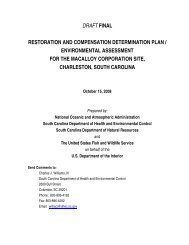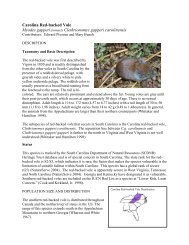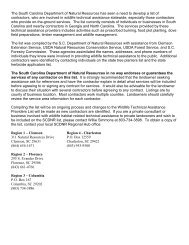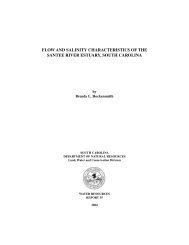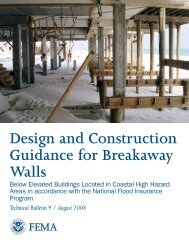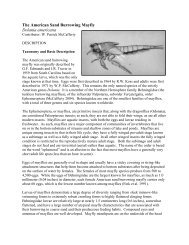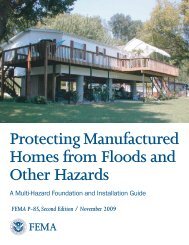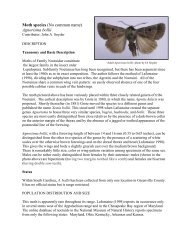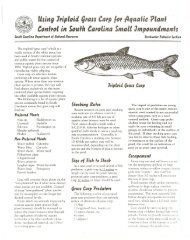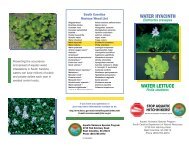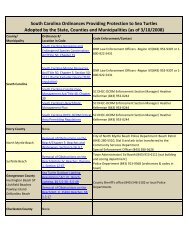Marsh Periwinkle Littoraria irrorata - South Carolina Department of ...
Marsh Periwinkle Littoraria irrorata - South Carolina Department of ...
Marsh Periwinkle Littoraria irrorata - South Carolina Department of ...
Create successful ePaper yourself
Turn your PDF publications into a flip-book with our unique Google optimized e-Paper software.
<strong>Marsh</strong> <strong>Periwinkle</strong><br />
<strong>Littoraria</strong> <strong>irrorata</strong><br />
Contributors: Keith Walters and Loren Coen<br />
Keith Walters<br />
DESCRIPTION<br />
Taxonomy and Basic Description<br />
The marsh periwinkle was first described in the United States by<br />
Say in 1822 from specimens collected along the Atlantic shoreline<br />
(Say 1822). This gastropod, in the order Mesogastropoda,<br />
belongs to an important genus <strong>of</strong> common marsh snails. They can reach a size up to 30 mm<br />
(1.25 inches) in total length. Individual snails are hermaphroditic and capable <strong>of</strong> reproduction<br />
throughout the summer. In <strong>South</strong> <strong>Carolina</strong>, maximum settlement <strong>of</strong> young typically occurs in<br />
early to late spring with shell growth to maximum length taking approximately two to three<br />
years. Adult snails can range in color from dark brown to an almost bleached white.<br />
Status<br />
Although the marsh periwinkle is not a threatened or endangered species, it is an important<br />
component <strong>of</strong> the intertidal salt marsh community. <strong>Periwinkle</strong>s may be a major participant in the<br />
decomposition <strong>of</strong> cordgrass, Spartina alterniflora, leaves (Bärlocher and Newell 1994; Silliman<br />
and Newell 2003) through a mutualistic association with leaf fungi (Silliman and Newell 2003).<br />
<strong>Marsh</strong> periwinkle can serve as an indicator species <strong>of</strong> the health <strong>of</strong> salt marsh habitat, a type that<br />
is critical for many species <strong>of</strong> marine invertebrates and migratory birds.<br />
POPULATION DISTRIBUTION AND SIZE<br />
Keith Walters<br />
The marsh periwinkle is distributed from New England to the<br />
Gulf Coast <strong>of</strong> Texas. In <strong>South</strong> <strong>Carolina</strong>, it can be found<br />
within vegetated landscapes, from the low water line all the<br />
way to the terrestrial scrub community in most estuarine salt<br />
marshes. Although it is an apparently abundant and common<br />
species (pers. obs), little is known in <strong>South</strong> <strong>Carolina</strong><br />
regarding long-term population trends and related<br />
information. Seasonal densities in the mid-marsh can range<br />
from 50 to 300 individuals per square meter, with greater<br />
densities observed during winter months (pers. obs.).<br />
HABITAT AND NATURAL COMMUNITY REQUIREMENTS<br />
The marsh periwinkle is an obligate salt marsh resident in which cordgrass may be considered a<br />
critical habitat. Individuals can be found inhabiting high-marsh areas around freshwater seeps<br />
and low-marsh stems submerged in full strength seawater (greater than 25 parts per thousand).<br />
Short-term studies (less than 2 years) indicate densities within the low marsh zone tend to be<br />
lower (less than 100 per square meter) compared to mid-marsh elevations (over 300 per square<br />
1
meter). Snails are also commonly found above the high water line on the stems <strong>of</strong> marsh plants;<br />
evidence suggests this climbing behavior is in response to blue crab predators (Hamilton 1976;<br />
Vaughn and Fisher 1992). <strong>Marsh</strong> periwinkles feed on microalgae and detritus; they may also<br />
garden and consume fungal decomposers found on the surface <strong>of</strong> marsh plants (Silliman and<br />
Newell 2003).<br />
CHALLENGES<br />
Major challenges to conservation <strong>of</strong> the salt marsh periwinkle include the loss <strong>of</strong> habitat and<br />
dramatic alterations to predator populations. Recently, marsh periwinkle has been implicated as<br />
a critical consumer <strong>of</strong> cordgrass and increased snail densities may responsible for observed<br />
declines in intertidal cordgrass coverage (Silliman and Bertness 2002). Increased marsh<br />
periwinkle densities are attributed to reductions in a major predator, the blue crab, Calinectes<br />
sapidus (Silliman and Bertness 2002). Reductions in marsh acreage or quality will also affect<br />
snail foraging and survival. Snails appear to have an obligatory relationship with cordgrass and<br />
the loss <strong>of</strong> cordgrass habitat would suggest a negative effect on snail populations. However,<br />
snails also appear to have a reciprocal negative effect on cordgrass in the absence <strong>of</strong> “natural<br />
densities” <strong>of</strong> predators. The cause <strong>of</strong> what appears to be an out <strong>of</strong> balance predator/prey dynamic<br />
between blue crabs and marsh periwinkle needs to be determined.<br />
CONSERVATION ACCOMPLISHMENTS<br />
The marsh periwinkle has received little or no attention in terms <strong>of</strong> past conservation efforts,<br />
likely in part because <strong>of</strong> the species ubiquitous distribution within coastal salt marshes.<br />
CONSERVATION RECOMMENDATIONS<br />
• Further investigate the theory <strong>of</strong> top-down regulation <strong>of</strong> cordgrass biomass by marsh<br />
periwinkle.<br />
• Determine whether blue crab predation is capable <strong>of</strong> regulating the distribution and<br />
abundance <strong>of</strong> periwinkles.<br />
• Determine the preferred food(s) <strong>of</strong> marsh periwinkles.<br />
• Determine whether recruitment is responsible for the initial distribution and abundance <strong>of</strong><br />
marsh periwinkle in the marsh.<br />
• Determine dispersing capabilities <strong>of</strong> marsh periwinkle.<br />
• Determine whether cordgrass characteristics and/or environmental conditions determine<br />
snail consumption.<br />
• Determine the fraction <strong>of</strong> the overall productivity <strong>of</strong> a marsh that is processed by snails.<br />
• Determine the role <strong>of</strong> marsh periwinkle in observed declines <strong>of</strong> cordgrass.<br />
• Determine factors other than predation and cordgrass quality that may account for the<br />
patchy distribution <strong>of</strong> marsh periwinkle in the field.<br />
2
MEASURES OF SUCCESS<br />
A better understanding <strong>of</strong> the role <strong>of</strong> cordgrass/marsh periwinkle/blue crab dynamics is one<br />
measure <strong>of</strong> success. Conservation <strong>of</strong> blue crab populations would presumably restore balance to<br />
the salt marsh systems, which would be another measure <strong>of</strong> success.<br />
LITERATURE CITED<br />
Bärlocher, F. and S.Y. Newell, 1994. Growth <strong>of</strong> the salt marsh periwinkle <strong>Littoraria</strong> <strong>irrorata</strong> on<br />
fungal and cordgrass diets. Marine Biology. 118:109-114.<br />
Hamilton, P.V. 1976. Predation on Littorina <strong>irrorata</strong> by Callinectes sapidus (Crustacea:<br />
Portunidae). Bulletin <strong>of</strong> Marine Science. 26:403-409.<br />
Say, T. 1822. An account <strong>of</strong> some <strong>of</strong> the marine shells <strong>of</strong> the United States<br />
Journal <strong>of</strong> the Academy <strong>of</strong> Natural Sciences <strong>of</strong> Philadelphia 2 221-248,<br />
257-276, 302-325.<br />
Silliman, B.R. and M.D. Bertness. 2002. A trophic cascade regulates salt marsh primary<br />
production. PNAS. 99:10500-10505.<br />
Silliman, B.R. and S.Y. Newell. 2003. Fungal farming in a snail. PNAS. 100:16643-16648.<br />
Vaughn, C.C. and F.M. Fisher. 1992. Dispersion <strong>of</strong> the salt marsh periwinkle <strong>Littoraria</strong> <strong>irrorata</strong>:<br />
effects <strong>of</strong> water level, size, and season. Estuaries. 15:246-250.<br />
3



